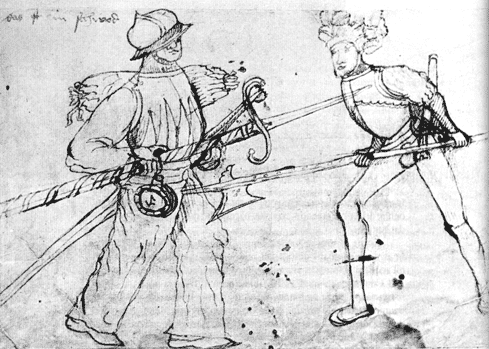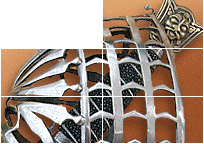| Author |
Message |
Eric Nower

Location: Upstate NY Joined: 22 Dec 2004
Posts: 174
|
 Posted: Tue 12 Apr, 2005 8:42 am Post subject: 13-14th century quivers Posted: Tue 12 Apr, 2005 8:42 am Post subject: 13-14th century quivers |
 |
|
Hello all,
Does anyone have any pictures or references to any books that would show me what kind of quivers medieval Europe archers would of used in the 13th and 14th centuries? Were they shoulder or hip mounted? Were they open or enclosed? Were they lined? Shapes and sizes would be great, if I could get them.
I've checked down with local libarary and have come up empty. Barnes and Noble didn't have any books that had what I was looking for.
Any help with this would be greatly appreciated!
May God have mercy on my enemies, for I shall have none.
|
|
  |
 |
|
Jeff Johnson
|
 Posted: Tue 12 Apr, 2005 9:30 am Post subject: Posted: Tue 12 Apr, 2005 9:30 am Post subject: |
 |
|
The Europeans never really used quivers for arrows. They usually either stuck them in their belt or toted linen arrow-bags. You can find an illustration of one in the Osprey "Warrior series #11 English Longbowman - 1330-1515" - one of the better Osprey books and good for general archer info.
You DO find quivers in the East though - especially mounted archers who had to acess their arrows while riding.
|
|
 |
 |
Elling Polden

|
 Posted: Tue 12 Apr, 2005 11:57 am Post subject: Posted: Tue 12 Apr, 2005 11:57 am Post subject: |
 |
|
My copy of the norwegian royal saga's have a picture of a quiver, from the colection of the national museum.
It appears to be made of wood, not unlike the crosbow bolt quiver in the Albums:
http://www.myArmoury.com/albums/displayimage....amp;pos=19
It is, naturaly, longer, but seems to be all wood, with leather straps...
"this [fight] looks curious, almost like a game. See, they are looking around them before they fall, to find a dry spot to fall on, or they are falling on their shields. Can you see blood on their cloths and weapons? No. This must be trickery."
-Reidar Sendeman, from King Sverre's Saga, 1201
|
|
    |
 |
Martin Wallgren

|
 Posted: Tue 12 Apr, 2005 12:15 pm Post subject: Posted: Tue 12 Apr, 2005 12:15 pm Post subject: |
 |
|
The sack on the back of the peasantwarrior is said to be a arrowholder in this drawing by Paul Dolstein, a german Landsknecht in service of the Danish King fighting in Sweden in the beginning of the 16th c.
 Attachment: 73.02 KB Attachment: 73.02 KB

Swordsman, Archer and Dad
|
|
    |
 |
|
Michael P Smith
|
 Posted: Tue 12 Apr, 2005 12:22 pm Post subject: Posted: Tue 12 Apr, 2005 12:22 pm Post subject: |
 |
|
| Jeff Johnson wrote: | The Europeans never really used quivers for arrows. They usually either stuck them in their belt or toted linen arrow-bags. You can find an illustration of one in the Osprey "Warrior series #11 English Longbowman - 1330-1515" - one of the better Osprey books and good for general archer info.
You DO find quivers in the East though - especially mounted archers who had to acess their arrows while riding. |
I certainly agree for the period being discussed, though there seem to be some quivers on the Bayeaux Tapestry. Most are hip mounted, but a couple SEEM to be back quivers (I know there is some controversy here, though it seems clear enough to me).
Mike
|
|
  |
 |
Sean Flynt

|
|
   |
 |
|
Eric Myers
Location: Sacramento, CA Joined: 23 Aug 2003
Posts: 214
|
 Posted: Tue 12 Apr, 2005 2:41 pm Post subject: Posted: Tue 12 Apr, 2005 2:41 pm Post subject: |
 |
|
The bulk of an army's arrows were carried in carts and distributed before a battle. However, I believe there are references to linen bags acting as quivers, sometimes with a wickerwork armature inside, and leather spacers to keep the arrows from puncturing through and the fletching from rubbing off. These bags have a single strap and have the arrows hanging horizontally around waist level, rather than down the back. both ends of the bag could be opened (drawstring) to allow for loading or drawing the arrows. IIRC, the rear spacer had holes for the nocks and would be left in place, while the front end of the back would be opened, and possibly pushed behind the arrowheads. Arrows would then be drawn forward to remove them. Also, I think arrows were somewhat regularly carried by simply thrusting them through the belt, tips forward (this is how I prefer to hold them when I shoot, but its not a great system for going through lots of brush.
Historic Enterprises sells a linen arrow bag, but they have removed most of the good pictures of it. Also, I think that Robert Hardy's book "Longbow" talks more about this, and may have some pictures of some spacers. The Mary Rose Museum online used to have pictures of the spacers I think, but no longer.
Eric Myers
Sacramento Sword School
ViaHup.com - Wiki di Scherma Italiana
|
|
  |
 |
|
Eric Myers
Location: Sacramento, CA Joined: 23 Aug 2003
Posts: 214
|
|
  |
 |
Eric Nower

Location: Upstate NY Joined: 22 Dec 2004
Posts: 174
|
 Posted: Tue 12 Apr, 2005 5:49 pm Post subject: Posted: Tue 12 Apr, 2005 5:49 pm Post subject: |
 |
|
Hello all,
Thanks for the replies...they're helping. For the most part the arrows were carried in a linen bag, through the belt, or distributed before the battle....gotcha. What about simple hunting? I suppose what I'm asking is were there any leather quivers recorded or used anywhere in Europe? If so, when were they used? Why use linen over leather? I know leather was used in making some forms of light amour and such, but why not in a quiver? Was it to costly or hard to come by?
I'm unsatisfied with my current quiver and I'm not impressed with what I've seen at local shops for the market and am thinking of making my own. Thank you everybody for your responses 
Yeah, Sean I wouldn't want to be jamming broadheads into my thighs until it was time to fire them......that just looks painful. 
May God have mercy on my enemies, for I shall have none.
|
|
  |
 |
|
Jeff Johnson
|
|
 |
 |
Stefan Toivonen

|
 Posted: Wed 13 Apr, 2005 7:19 am Post subject: Posted: Wed 13 Apr, 2005 7:19 am Post subject: |
 |
|
Here is a picture from the Maciejowski bible with archers that have arrows in their belt.
 Attachment: 54.92 KB Attachment: 54.92 KB

|
|
  |
 |
Greyson Brown

|
 Posted: Wed 13 Apr, 2005 7:53 am Post subject: Posted: Wed 13 Apr, 2005 7:53 am Post subject: |
 |
|
While it focusses almost exclusively on military archers, the book The Medieval Archer (sorry I forgot who the author is) covers some of the information that you are after. While the previous comments about tucking arrows through belts, and carrying them in carts are correct, I think there is still a little tenuous evidence for quivers. All told, though, an arrow bag is probably what you are going to want.
-Grey
"So long as I can keep the path of honor I am well content."
-Sir Arthur Conan Doyle, The White Company
|
|
  |
 |
Eric Nower

Location: Upstate NY Joined: 22 Dec 2004
Posts: 174
|
 Posted: Wed 13 Apr, 2005 9:21 am Post subject: Posted: Wed 13 Apr, 2005 9:21 am Post subject: |
 |
|
Hello again,
Thanks everyone! I love this site! I'm gonna go down to the bookstore and try to find some of these books. It's interesting to me that the linen sac and the belt was the primary method of transportation. Great care must of been given in the feild to care and maintenaince of the arrows. I love the pictures, by the way, quite impressive. If anyone is interested I'll post pics of my quiver when I get it done....after a little more research  Thanks to everyone!!! Thanks to everyone!!! 
May God have mercy on my enemies, for I shall have none.
|
|
  |
 |
|
Eric Myers
Location: Sacramento, CA Joined: 23 Aug 2003
Posts: 214
|
 Posted: Wed 13 Apr, 2005 10:19 am Post subject: Posted: Wed 13 Apr, 2005 10:19 am Post subject: |
 |
|
| Greyson Brown wrote: | While it focusses almost exclusively on military archers, the book The Medieval Archer (sorry I forgot who the author is) covers some of the information that you are after.
|
Yes! That book is an excellent resource, its by Jim Bradbury, and his book The Medieval Siege is also quite good.
Eric Myers
Sacramento Sword School
ViaHup.com - Wiki di Scherma Italiana
|
|
  |
 |
Elling Polden

|
 Posted: Thu 14 Apr, 2005 12:57 am Post subject: Posted: Thu 14 Apr, 2005 12:57 am Post subject: |
 |
|
In general, hunters do not need enough arrows to warant a quiver, and soldiers need more than a quiver can carry.
The archers in the Bayoux tapestry are often horse archers, or dismounted such.
These troops would need quivers, because they need to bring ready arrows with them on the move.
"this [fight] looks curious, almost like a game. See, they are looking around them before they fall, to find a dry spot to fall on, or they are falling on their shields. Can you see blood on their cloths and weapons? No. This must be trickery."
-Reidar Sendeman, from King Sverre's Saga, 1201
|
|
    |
 |
Greyson Brown

|
 Posted: Sat 16 Apr, 2005 1:38 am Post subject: Posted: Sat 16 Apr, 2005 1:38 am Post subject: |
 |
|
| Eric Myers wrote: | Greyson Brown wrote:
While it focusses almost exclusively on military archers, the book The Medieval Archer (sorry I forgot who the author is) covers some of the information that you are after.
Yes! That book is an excellent resource, its by Jim Bradbury, and his book The Medieval Siege is also quite good. |
Now you're going to go and make me spend more money on books. And THAT means another book shelf. I love you guys. 
-Grey
"So long as I can keep the path of honor I am well content."
-Sir Arthur Conan Doyle, The White Company
|
|
  |
 |
Eric Nower

Location: Upstate NY Joined: 22 Dec 2004
Posts: 174
|
 Posted: Sun 15 May, 2005 11:22 am Post subject: Posted: Sun 15 May, 2005 11:22 am Post subject: |
 |
|
Hello all,
I'm about 1/2 way through "the Medival Archer" and am findng it to be an interesting read. I finished my quiver....not bad for a first attempt.... I'm no leatherworker.....and I'm domestically challenged as far as the lacing goes, but it came out alright I think.  Here's a couple pics. The original quiver was nothing more than a round tube about 14" long. I didn't like the way it was suspended or the length of the tube....it didn't give enough support to keep the arrows in while i was walking. Here's a couple pics. The original quiver was nothing more than a round tube about 14" long. I didn't like the way it was suspended or the length of the tube....it didn't give enough support to keep the arrows in while i was walking.
This one measures about 23 1/2" long and tapers from 4" to 3" at the bottom of the quiver. I used a heavy 7-8oz leather for the quiver and went with genuine sinew for the laces. the belt loops are made from a light 3-4 oz leather.
May God have mercy on my enemies, for I shall have none.
|
|
  |
 |
|
|

